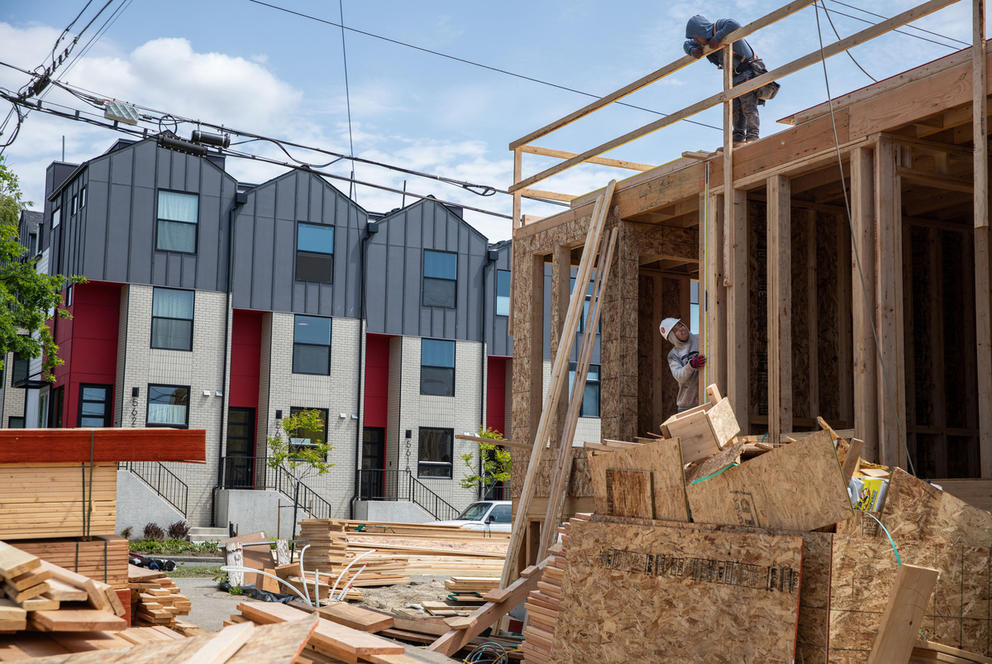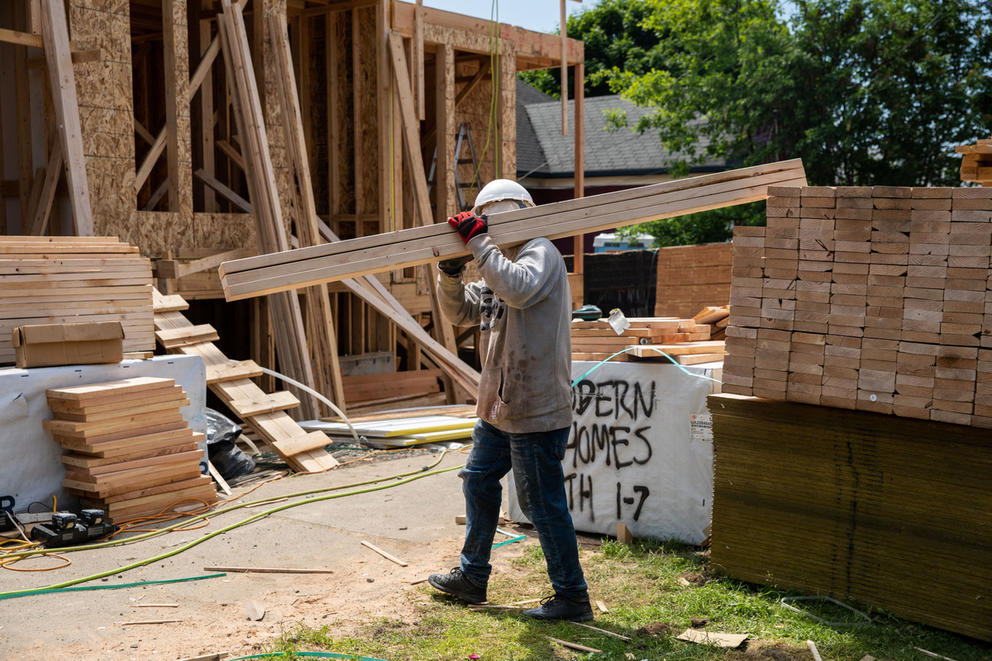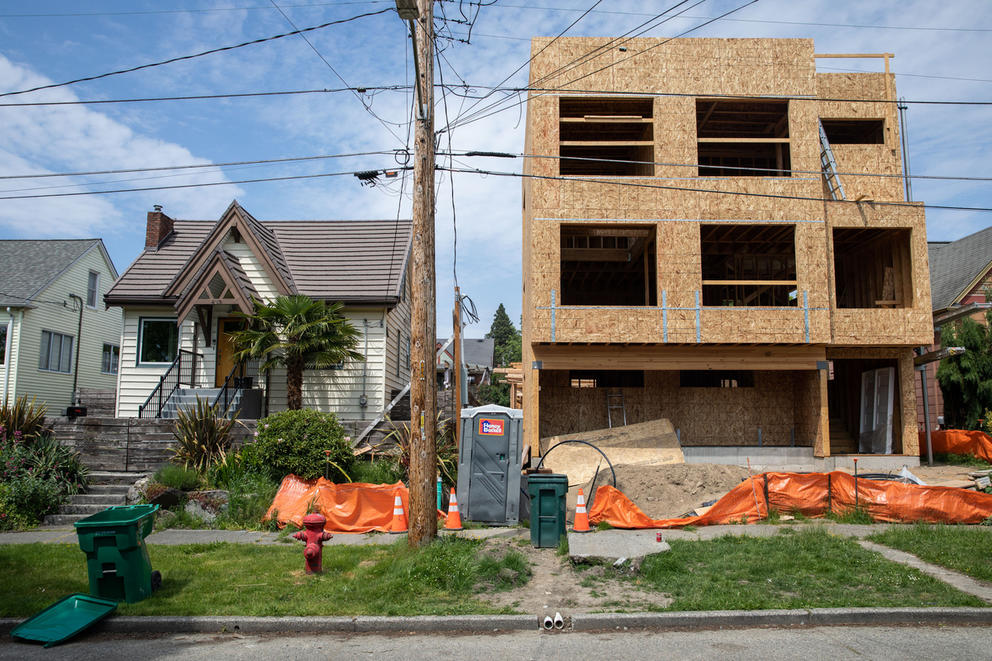Enter missing middle housing: two- to six-unit homes that provide greater density than single-family houses. Developers have long been able to build such homes — mostly in the form of tall skinny townhome clusters — in the cores of Seattle’s urban villages. But, in the vast majority of residential neighborhoods, single-family homes have been the only legal option.
Now, thanks to the state Legislature’s new missing middle zoning law, developers will be able to build four- to six-home projects across Seattle.
So what’s next for the city? Are we staring down a future where six-packs of tall skinny townhomes replace every single-family home in Seattle? Or will it be something much subtler? (Spoiler: much subtler.) Are any developers lining up to build small apartment complexes? How soon will these changes take place?
To get a sense of what’s coming down the line, Crosscut spoke to housing builders, advocates and policy experts who did their best to gaze into their crystal balls and predict what missing middle zoning might bring.
What the missing middle law does
House Bill 1110 was one of the marquee accomplishments of the Legislature’s “Year of Housing.” Sponsored by Jessica Bateman, D-Olympia, the law allows towns and cities to build two- to six-unit homes in zones previously restricted to single-family houses.
Cities with fewer than 25,000 residents can build duplexes everywhere. Those with 25,000-75,000 residents can build duplexes everywhere and fourplexes within a quarter mile of major transit stops (defined as a light rail, commuter rail, or bus-rapid transit stop). Cities with more than 75,000 residents can build four-unit projects everywhere and six-unit projects within a quarter mile of major transit stops.
There’s also an affordability bonus that allows developers in cities with more than 75,000 residents to build six-unit projects farther from transit if at least two of the units are subsidized affordable housing. Cities with 25,000-75,000 residents can build four units anywhere if one unit is subsidized affordable housing. Experts don’t think many for-profit developers will use the density bonus, but say it could be useful for nonprofit groups working on affordable homeownership.
“It’s a really big deal. … It used to seem impossible to see change at this scale,” said Alex Brennan, executive director at the nonprofit advocacy group Futurewise. “We’ve come a long way politically to get to the point where we’re able to see this happen in most cities across the state.”
The changes aren’t imminent for Seattle. The law states that cities must implement the new missing middle zoning allowances within six months of the passage of their next comprehensive plan update, which for Seattle won’t be until fall 2024.
How much housing will get built and where?
Because there are so many factors at play for what gets developed and where, it’s hard to estimate exactly how much housing will get built. A high-level analysis from the Puget Sound Regional Council provides a rough estimate of what’s coming regionwide, at least.
PSRC found that the new zoning could build between 75,000 and 150,000 units of new housing in cities in King, Kitsap, Pierce and Snohomish counties. The analysis assumes builders will take advantage of 25%-50% of the maximum development capacity, meaning there’s capacity for about 300,000 units of missing middle housing throughout the region.
Matt Hutchins, founder of CAST Architecture and a Seattle Planning Commission member, said that all the factors that make it challenging to build any project — having the “right lot, right zoning, right people, right financing” — mean new four- to six-unit projects won’t start popping up on every block. He guestimates it’ll be more like one new project every 10 blocks to start.
“That does still have a big impact across the city,” said Hutchins. “But neighborhood-by-neighborhood, street-by-street, the on-the-ground impact will be pretty gradual.”
Brennan of Futurewise thinks that in addition to simply adding new housing, the zoning changes will help take pressure off neighborhoods where multi-unit townhomes are already allowed to be built.
“One of the big goals of the policy is that we’re not expecting all of the new housing to just go in the urban villages in Seattle and few other urban centers around the region,” he explained. “We’re allowing some of the other urban neighborhoods to take some of that capacity too, which will hopefully ease some of the displacement pressures of rapid urban development in those places.”
Mayor Bruce Harrell, expressing concern about displacement, told Axios that he is considering trying to limit the density changes to 75% of areas that currently only allow single-family house construction. That limitation would require signoff from both the City Council and Washington Department of Commerce.
Existing homeowners’ associations are another hitch in the broad implementation of missing middle zoning. The Seattle Times reports that while the law prevents HOAs from adding new restrictions on higher-density zoning, it doesn’t supersede existing HOAs, meaning some of Seattle’s toniest neighborhoods and gated communities will not provide any of the additional housing the city needs.
What will developers build?
The new law specifies numbers of units, not housing types, meaning developers could build a wide variety of housing including townhomes, small apartment complexes, cottage housing with multiple small single-unit homes clustered on a single lot, and stacked flats where a multi-unit apartment or condo building has just one unit per floor.
But, there’s broad agreement that developers are likely to continue building four- to six-unit townhomes more than experimenting with other housing types. Developers and financiers are already comfortable with townhome construction. There’s less risk for developers to build and immediately sell than there is renting apartments and there’s already a market of interested homebuyers shopping for townhomes. All of that adds up to a development sector more likely to scale up to build more townhomes than adapt to build the alternative housing types allowed under missing middle zoning.
Those are all the same reasons that developers build townhomes instead of small apartment buildings right now in Seattle’s low-rise zones where both are legal. If the city is interested in getting more small apartments or stacked flats, Hutchins said it will need to provide incentives in the building code to make those housing types easier to finance and build.
But Dylan Sluder, government affairs manager at the Master Builders Association of King and Snohomish Counties, said even an influx of new townhomes would improve the health of the local housing market.
“As folks climb the ladder of homeownership they’ll move up from apartments to new townhomes, which opens up new opportunities for other people,” he said. “It’s addressing the supply issues at the most basic level of economics here. … This legislation will hopefully provide some entry level products for first time home buyers, workforce housing, help people buy housing that fits their lifestyle and provides amenities they want.”
No silver bullets
Nobody pretends that missing middle zoning alone will address the housing affordability crisis just about every town and city across Washington is experiencing. But there’s hope it will have some positive impact.
“The good news to me is we’re building about 28,000 housing units a year in the Puget Sound region, most of which is multifamily,” said Puget Sound Regional Council executive director Josh Brown. “A good goal for the region is to get that number up to 34,000 or 36,000 units a year. That feels achievable [with the addition of missing middle] if the economy stays solid.”
Brennan says coupled with other new state laws passed last session, missing middle zoning could go even further. For example, the Legislature created a new program to help right the wrongs of racially restrictive homeownership covenants that barred nonwhite people from buying homes. The program will help people barred by racial covenants in Washington or their descendants with down-payment assistance and closing costs for first-time homeownership.
“Hopefully this will both create new lower-cost homes to buy and provide financing to people who hadn’t had access to it before. Those two things should work together,” said Brennan.






